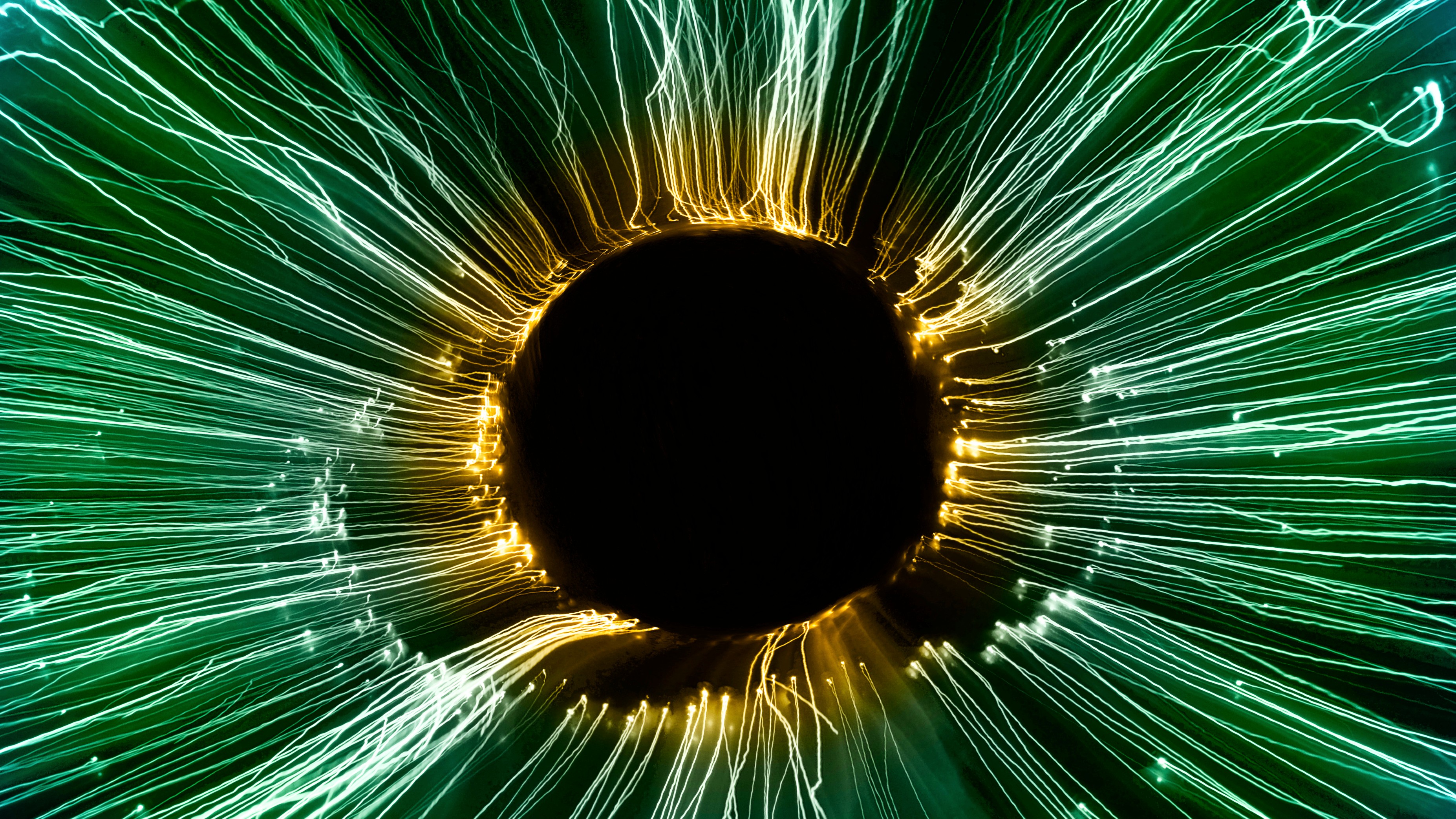Official verdict: JWST’s early galaxies didn’t break cosmology
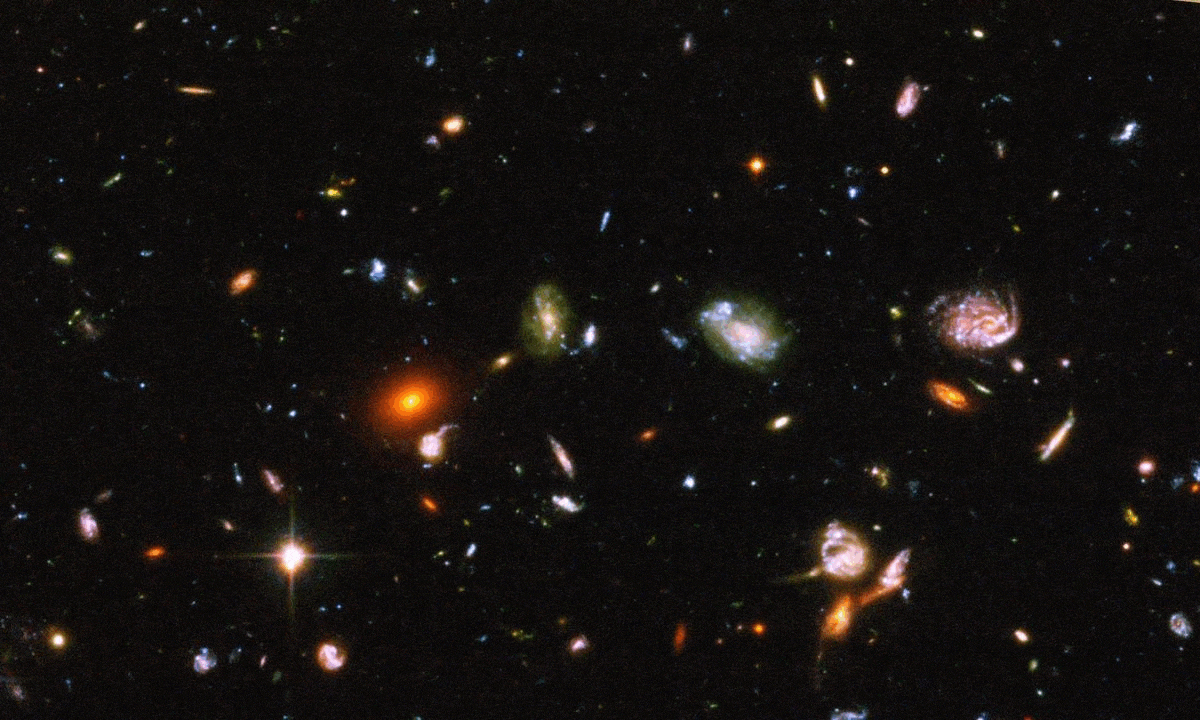
- Ever since JWST first opened its eyes onto the Universe, astronomers and astrophysicists have feasted upon a treasure trove of previously unseen marvels.
- Chief among the surprises was an unexpected abundance of very bright, ultra-distant objects never seen before: objects known as “little red dots.”
- While steps have been made to explain their presence in such great numbers, a complete explanation proved elusive. At last, a new study finally puts the final puzzle piece into place.
It’s hard to believe, but it was only two years ago, in the summer of 2022, that the very first science images from the James Webb Space Telescope (JWST) were unveiled to the world. Although they revealed remarkable details about newly forming planets, young stellar systems, exoplanets, stars with debris disks, galaxies, and much, much more, the greatest surprise came when looking to the greatest distances of all. Out there, amidst the deepest cosmic depths ever probed, were an unexpected population of galaxies — in large numbers — that were incredibly distant, red in color, point-like in size, and yet were still bright enough to be easily detected by JWST’s instruments.
These objects, known colloquially as “little red dots,” presented a challenge for modern cosmology. We already had a very precise picture of what the ingredients in our Universe were: a mix of dark energy, dark matter, normal matter, and a tiny bit of radiation, and we already knew how old the Universe was and how we expected structure to form within it. So why were there so many of these bright objects appearing at such early times: in greater abundances and greater numbers than any simulation predicted?
There’s an old saying in astronomy and physics: that theorists can tell us how nature is expected to behave, but only with experimental or observational data can we determine how the Universe actually is. After two years of investigation, scientists have finally put the pieces together, learning at last how the Universe truly grew up.
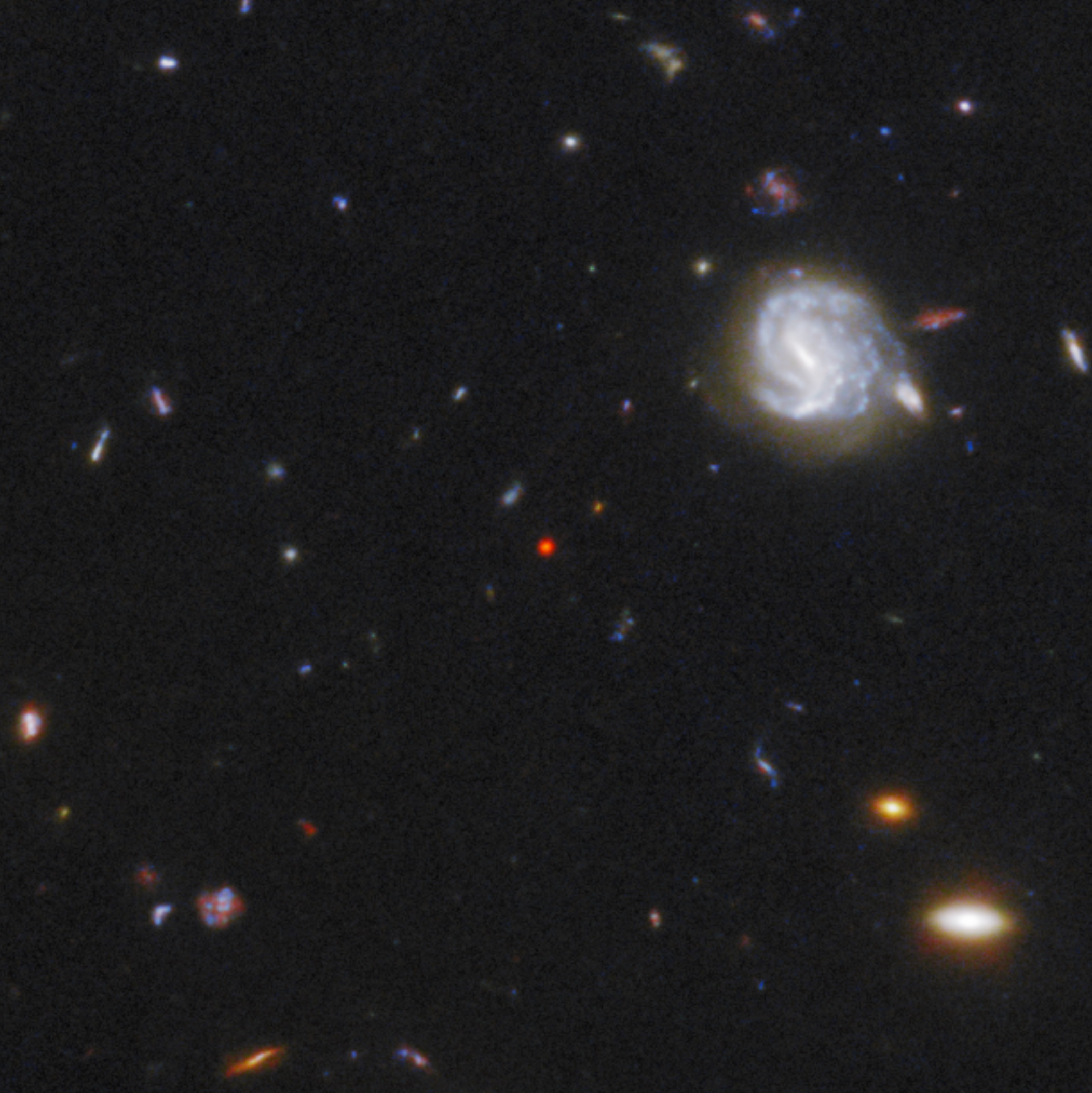
Theoretically, our picture of the Universe isn’t particularly malleable, at least on cosmic scales. We already have a suite of observations that cannot be ignored; everything else that we learn has to be explained within the same context as what we already know. In the early stages of the hot Big Bang, we know that there was an initial spectrum of density imperfections: underdense and overdense regions, that appear on all cosmic scales at approximately the 1-part-in-30,000 level. We observe these imperfections in the cosmic microwave background — the leftover radiation from the aftermath of the Big Bang — which were imprinted just 380,000 years after the hot Big Bang’s beginning.
We also know that, initially, there were no stars or galaxies, and that the Universe took substantial amounts of time (at least tens of millions of years) for the very first stars to form. Early on in cosmic history, galaxies were:
- smaller,
- less massive,
- less structurally evolved,
- with fewer heavy elements,
- and dominated by bluer, younger populations of stars,
compared to galaxies today. We knew what the Universe was like in its very early stages, and we knew what the Universe was like once galaxies became abundant: right up to the limits of observatories like the Hubble Space Telescope. But what would JWST discover? In order to find out, we had to acquire those critical observations.

Some of what JWST found was expected, at least by some. The cosmic distance record for most distant object was broken several times, as was the record for the most distant galaxy cluster, the most distant gravitational lens, along with numerous other revolutionary finds. Some of the things that JWST saw were on the fringes of what we expected to be there: large numbers of early galaxies that strained the limits of how massive we thought galaxies could get to be after such short periods of time. And some of what JWST saw was wholly unexpected by almost everyone, such as the presence of early, supermassive black holes that clearly didn’t form from the stars present within the early proto-galaxies that hosted them.
Among the more unexpected finds were the presence and abundance of these “little red dots,” which we swiftly realized were primarily due to early, bright galaxies that appeared very shortly after the Big Bang in terms of cosmic history. Although a few of these galaxies turned out to be intrinsically red objects that were less distant (and hence, from later times in the Universe’s history), most of the little red dots truly did correspond to young, bright galaxies. Moreover, the number of “little red dot” galaxies that we were finding was truly stretching the limits of what simulations indicated was possible.
Why were there so many of these very bright galaxies at such early times? This was one of the key puzzles that astronomers and astrophysicists had to face when confronted with the novel JWST data.
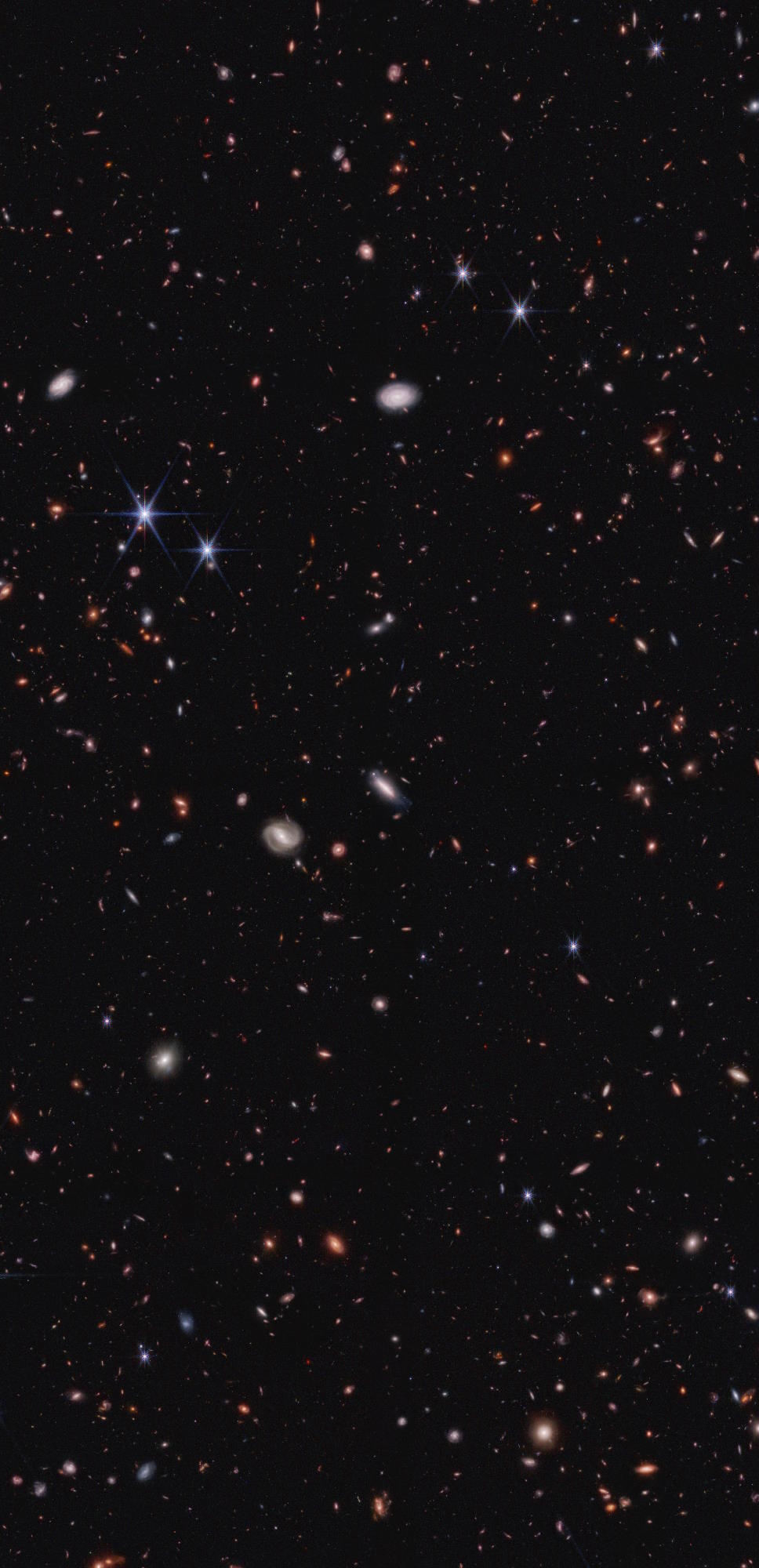
It’s easy to declare, “no one expected this,” and even easier to leap to a fantastical conclusion, such as “cosmology is broken” or “our model of the Universe can’t be reconciled with these observations.” But much more challenging — at least, from a scientific perspective — is to look at the unexpected and try to find the underlying explanation for how these objects came to be. After all, it was the Hubble Space Telescope that revealed to humanity what the Universe looked like, but it would fall to JWST to teach us how the Universe grew up and came to be the way that it is today. It may not have told us what we expected it would tell us, but that’s ok: being wrong gives us an opportunity to learn something new.
The first thing people took a detailed look at was the performance of JWST itself. One of the most important aspects of any telescope isn’t just understanding properties like its resolution, light-gathering power, and wavelength sensitivity, but a mandatory understanding of how the entire optical system works, as well as the efficiency of that system. No telescope is optically perfect, as there are always losses due to:
- reflections off of surfaces,
- any dust or dirt that’s accumulated on the optical surfaces,
- degradations or imperfections in the mirrors themselves,
- even the tiniest, most minuscule misalignments in the mirrors or instruments,
- as well as thermal noise and imperfect properties within the instruments themselves.

It turned out that, when it came to JWST, scientists had calculated the expected performance of the overall observatory based on these factors. When it came to crunch time, however, the telescope itself turned out to actually outperform those expectations, as JWST was kept cleaner and more pristine than any other space telescope ever built and constructed. JWST’s views of the Universe were all at once:
- sharper,
- lower in noise,
- and optically more efficient,
than even the most optimistic of predictions. Its point-spread function (PSF), or how well it can focus the light from distant targets, is practically twice as sharp as the design requirements, making it the best telescope ever on this front in human history.
This meant that sharper images and fainter point-like objects could be revealed in less time than was anticipated, and also that objects that were revealed would appear brighter than expected in a given amount of observing time. This is important information for properly calibrating any observations acquired with JWST, as how bright an object appears through your telescope is essential information for determining its intrinsic properties, including how intrinsically bright it is. While this plays a role in the observed brightness of objects seen with JWST, it couldn’t fully explain why these “little red dots” were so bright and abundant.
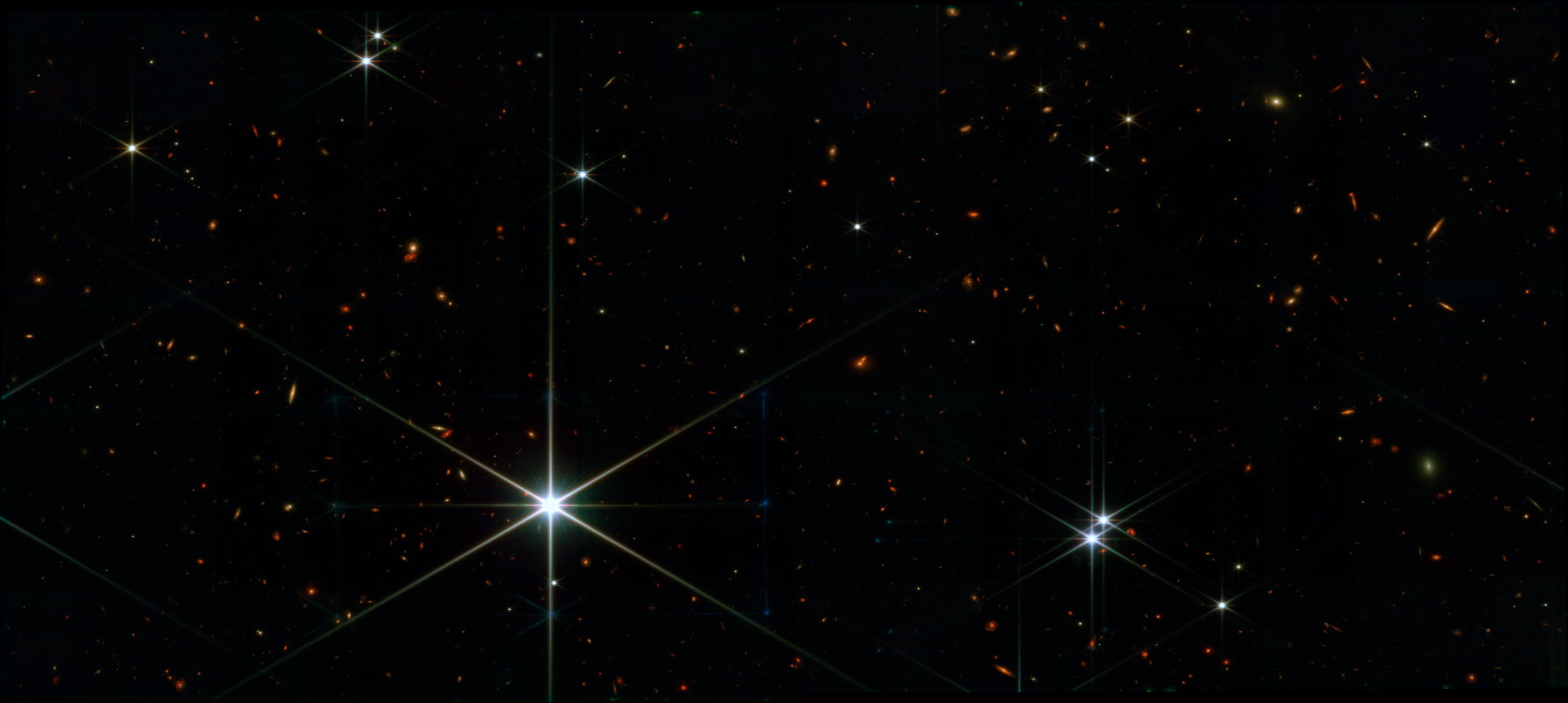
Another important aspect was to check the simulations we were performing, as we were attempting to try to predict what sorts of stars and galaxies we expected to see early on in cosmic history. The most comprehensive simulations, prior to JWST’s observations, had difficulty reproducing the copious numbers of massive, evolved galaxies that were revealed by JWST. These large-scale simulations, however, had limitations: they were limited both in terms of mass resolution and in terms of spatial resolution, which is something you have to sacrifice in order to get accurate simulations on large cosmic scales.
However, a 2023 study, which investigated simulations on slightly smaller cosmic scales but with much greater mass and spatial resolution, revealed that it was the regions that began with the greatest mass overdensities on relatively small cosmic scales — regions that were cosmically rare at the 1-part-in-10,000 level — that contributed greatly to the earliest and most massive young galaxies. These regions were “washed out” in the lower-resolution simulations, but were primarily responsible in the higher-resolution simulations for the greatest number of high-mass galaxies formed between 250 and 500 million years after the Big Bang. This greatly reduced the tension between expectations and observations, but didn’t eliminate it entirely.
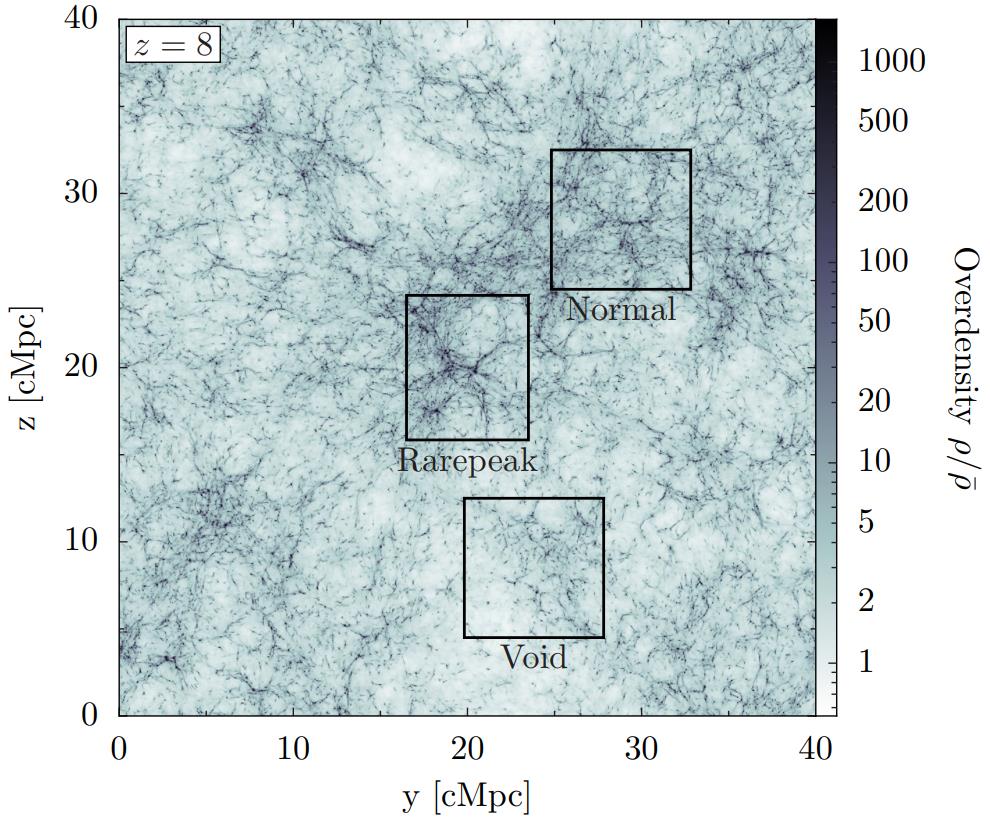
One of the puzzles that still remained was why the galaxies that JWST was seeing at the earliest times were so bright in specific wavelengths of light: in the ultraviolet light they were producing. We know that star-formation creates stars of all different masses, from the high-mass bright, blue, but short-lived stars to the lower-mass fainter, redder, and longer-lived stars. It had typically been assumed that stars formed continuously within galaxies, and so as the blue stars within older stellar populations aged and died, new ones would arise to take their place. However, many galaxies that were observed appeared to defy this trend, with more ultraviolet emission than modern astrophysics predicted.
Again, it would have been very easy to assert that “cosmology is broken” or even that “astrophysics, including stellar modeling, is broken,” but the ultimate goal is always to understand what nature is doing and how it’s doing it. A key realization occurred in late 2023: that galaxies don’t typically form stars continuously and at the same rate, but rather are punctuated and highlighted by brief events known as starbursts. Starbursts, today, typically only occur in small regions within most galaxies, creating gigantic amounts of ionized hydrogen and leading to a rapid period of star-formation: where large populations of stars, including short-lived, massive, ultraviolet-emitting blue stars, all form at once.
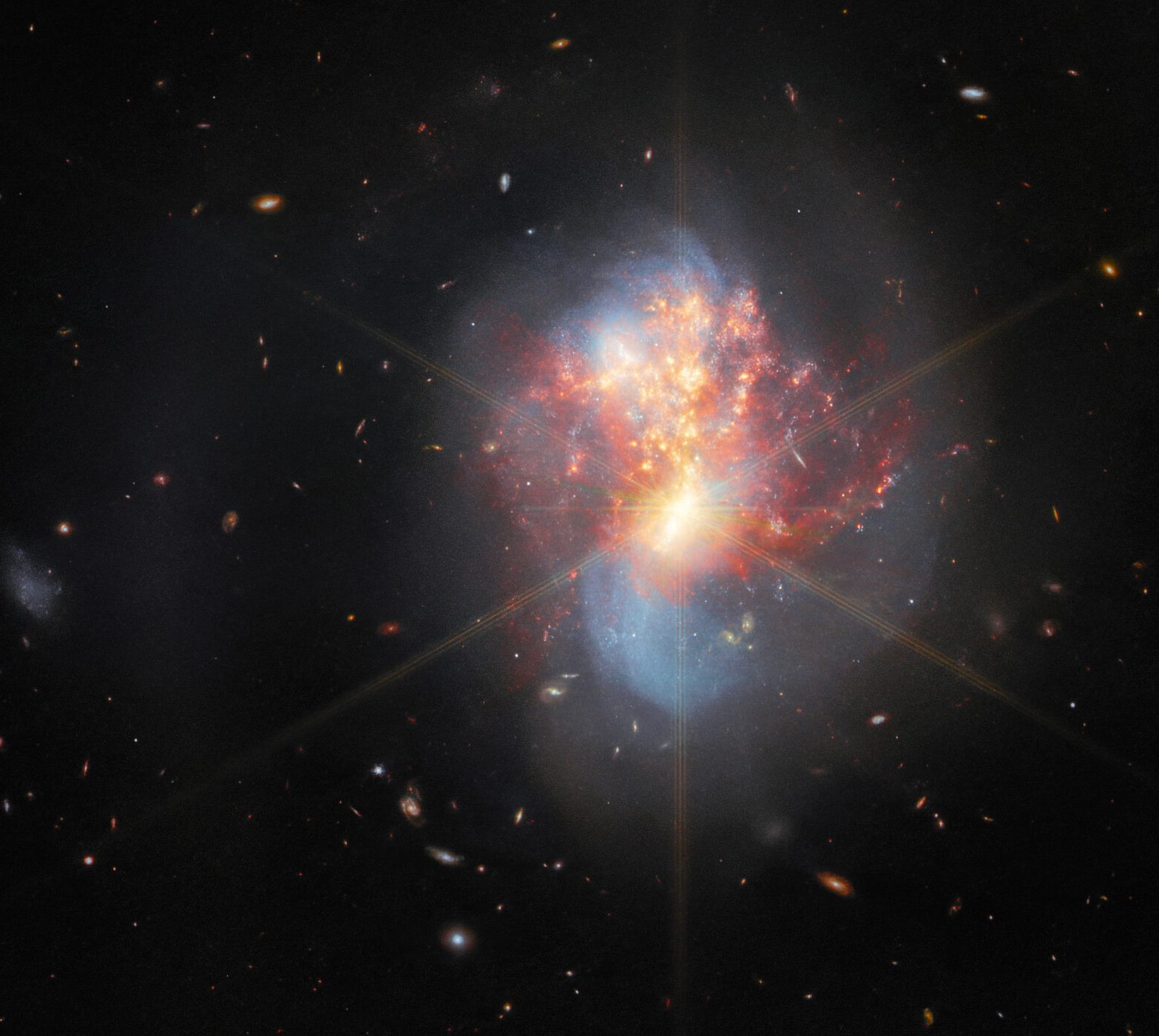
The recognition that star-formation wasn’t continuous early on, but rather was “bursty” in exactly this fashion, was extremely important. In these small, early galaxies, it was very likely that the entire galaxy itself could be undergoing a starburst, where stars formed all at once all throughout it. These episodes would dramatically — but only temporarily — increase a galaxy’s brightness. Our unstated assumption that “light traces mass” was not necessarily true; light can spike from transient episodes and outshine what’s expected for a galaxy’s given mass. These episodes of bursty star-formation, accompanied by giant and supergiant stars, as well as supernovae, could definitely help explain why so many bright galaxies were seen so early on.
But now, in a brand new study, scientists from the CEERS (Cosmic Evolution Early Release Science) team, working with some of the earliest JWST data, have identified a fourth contributor to these bright, early galaxies: light that’s being emitted — again, not continuously, but in bursts — by their central, supermassive black holes. One of the more surprising discoveries from JWST is that stars in a galaxy and the central supermassive black hole within a galaxy don’t exactly grow up together. Instead, it appears that the seeds of massive black holes, with masses between 10,000 and 100,000 solar masses, can form alongside or even prior to the very first stars, simply from colliding streams of cold gas.
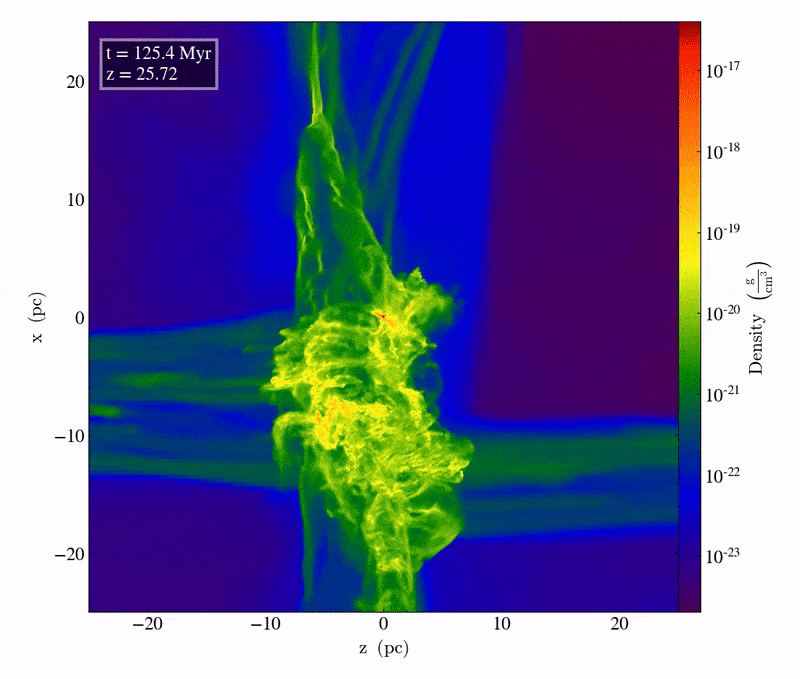
Today, the most massive black holes are huge, with tens of billions of solar masses inherent to them: about 0.1% of the stellar mass of those galaxies. But early on, black holes were still very massive, with tens of millions, hundreds of millions, or even a billion solar masses in just the first ~800 million years of cosmic history. Importantly, however, the galaxies that house them are much lower in mass than they are today, so that the black hole-to-stellar mass ratio of these galaxies isn’t 0.1%, but can be 1%, 10%, or even up to 100%. These are known as overmassive black holes, and when they’re active, they can shine very, very brightly.
All black holes, but especially overmassive black holes, can consume gas from their surroundings, and when they do, they heat the gas up. It can get so hot that the gas doesn’t just emit infrared (heat) light, but it can emit visible, ultraviolet, and even X-ray light. When we see a “little red dot” in the sky with JWST’s eyes, we’re seeing the sum total of all the light produced: light from the stars inside plus light from any active supermassive black hole activity occurring inside. Since they only appear as a single point, it’s very difficult to disentangle what light comes from what component of the galaxy. What’s remarkable is that — as has been done in a new study — when you account for this black hole-produced light in these “little red dots,” the remaining early galaxies are right in line with what the standard model of cosmology, or ΛCDM, predicts.
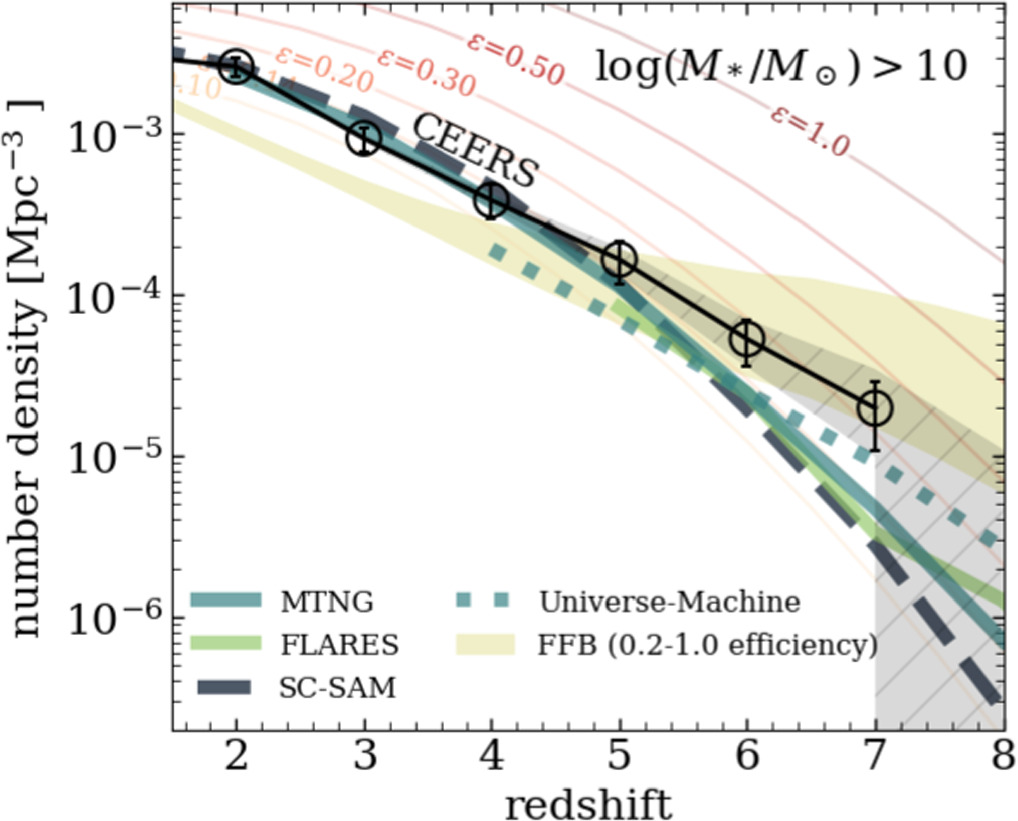
It’s often the case that we initially had an expectation for how something was going to work, and then when we put it to the test, we find that it doesn’t work that way after all. Sometimes this is due to a mistake, either in the equipment, the observational/experimental methodology, or in the theory that was used to make the key prediction. Sometimes this disagreement is a harbinger of a new scientific discovery, as mismatches between theory and observations in a novel regime are usually the first signals we get of a problem with our current way of thinking. But most frequently — and this is certainly the case here — we find that our “simple model” that we’ve been using to make predictions is too simple in a number of ways, and that we have to account more fully for the relevant contributing factors.
As the first author of the new study, UT-Austin graduate student Katherine Chworowsky, says about ideas in star-formation early on in our cosmic history:
“[T]here is still that sense of intrigue. Not everything is fully understood. That’s what makes doing this kind of science fun, because it’d be a terribly boring field if one paper figured everything out, or there were no more questions to answer.”
The bright, early galaxies that JWST sees as “little red dots” are most likely not as massive as astronomers and astrophysicists originally thought. But only by:
- understanding how to properly calibrate JWST,
- making more detailed, higher-resolution simulations of galaxy formation,
- accounting for the bursty nature of star-formation,
- and including the light generated by active supermassive black holes,
can we bring the observed Universe back in line with expectations. At last, the mystery of these “little red dots” has finally been solved.




